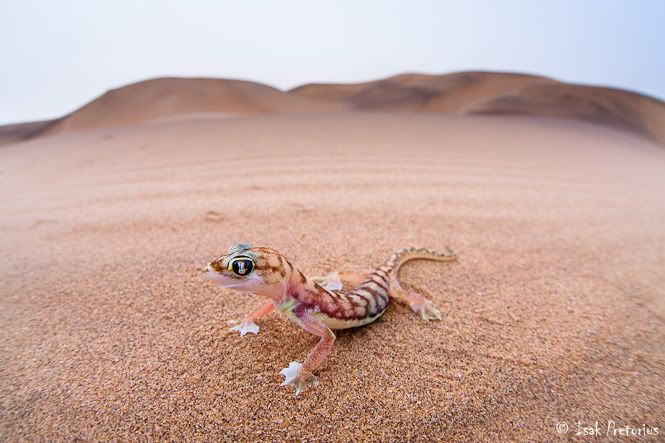Gecko in the dunes
Swakopmund, Namibia
Canon 1Ds Mark III | Sigma 15mm | 1/80 sec at f/11, ISO 800
With the help of a local guide we spent 4 days driving along the dunes and finding everything from scorpions, sidewinders, gecko's, chameleons and beetles. One of my photographic objectives was to capture the essence of the web-footed gecko. I was inspired by photographs of this little critter I've seen from Heinrich van den Berg. The geckos name originates from the web between their toes and is now known as the "palmato gecko". I still prefer "web-footed gecko". They are nocturnal with a beautiful light pink and blue translucent skin. Sunlight would kill them instantly so in the daytime they hide in the sand, about two feet under the surface. Early in the morning you still find them out on the dunes hunting for prey when there is fog. This usually only clears by 9am in the summer months. When they encounter any threat, like humans, their only defense is to run away.
I had a specific shot in mind. One where the gecko has a striking curved posture but where it also shows the environment they occur in. This required ultra wide angle portrait shots. I was faced with two problems: The fist is that the web-footed gecko is surprisingly small, only about 4cm long. This meant that if I wanted the gecko to appear large in my frame using an ultra wide lens, I had to get extremely close to it. All of my ultra wide lenses, the Canon 16-35mmf/2.8, Canon 10-22mmf/3.5 and the Nikon 14-24mmf/2.8 have a minimum focus distance that is too far, at around 25 millimeters. If I had the gecko in focus at the minimum focus distance it would result in it being too small in the frame. The solution was borrowing the Sigma 15mm fish-eye lens from a friend, with a minimum focus distance of a mere 15 millimeters. That is such a great lens and a pity it is not made anymore. Finding one second hand is almost impossible.
The second problem I was faced with was that I had to find a gecko specimen willing to be photographed at such a short distance, in the right location for the perfect backdrop, and with the perfectly curved posture. The answer to this was, of course, four days of trekking geckos across the dunes, multiple shots, multiple angles and cleaning a lot of sand grains off my equipment until I got the perfect shot that I had envisaged. There are many things I believe can be improved about this photograph, and I believe it's important never to feel too complacent about your results, but the four days of fun trying to capture the perfect frame was the prize for me.
This image won the April leg of a major South African wildlife photographic competition.






